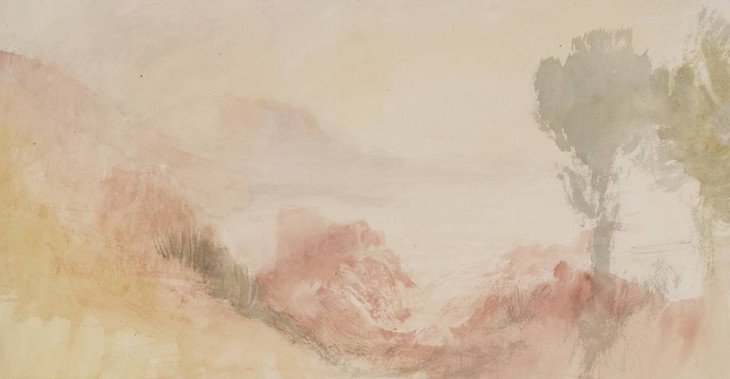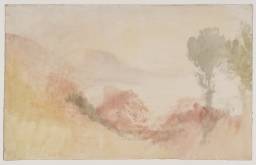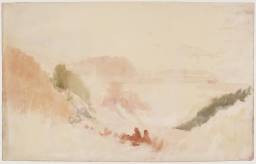From the entry
This section is comprised of two colour studies relating to Tancarville on the Seine (British Museum, London), a large finished watercolour which has been discussed in most depth by the art historians Kim Sloan and Ian Warrell. According to a label on the watercolour’s verso, it was painted for a member of the Swinburne family in 1839. Sir John Swinburne had purchased Turner’s 1811 painting Mercury and Herse (private collection), and further patronage from the family followed until 1820. Tancarville on the Seine represents a considerably later commission, possibly prompted by a project to have Mercury and Herse engraved to form a pair with the later Mercury and Argus (National Gallery of Canada, Ottowa); this had brought Turner into renewed contact with the Swinburne family, who still owned the former painting. Warrell categorised Turner’s finished view of Tancarville as one of five ‘dazzling’ watercolours produced around 1840 with the possibility of ...
References
This section is comprised of two colour studies relating to Tancarville on the Seine (British Museum, London1), a large finished watercolour which has been discussed in most depth by the art historians Kim Sloan and Ian Warrell. According to a label on the watercolour’s verso, it was painted for a member of the Swinburne family in 1839. Sir John Swinburne had purchased Turner’s 1811 painting Mercury and Herse (private collection2), and further patronage from the family followed until 1820.3 Tancarville on the Seine represents a considerably later commission, possibly prompted by a project to have Mercury and Herse engraved to form a pair with the later Mercury and Argus (National Gallery of Canada, Ottowa4); this had brought Turner into renewed contact with the Swinburne family, who still owned the former painting.5
Warrell categorised Turner’s finished view of Tancarville as one of five ‘dazzling’ watercolours produced around 1840 with the possibility of commercial engraving in mind, with Tancarville on the Seine thought to be the earliest of the group.6 The other four watercolours comprise views of the Rhine at Oberwesel (National Gallery of Art, Washington, DC), Lake Nemi (The British Museum, London), and two views of Heidelberg (Manchester Art Gallery; Private Collection).7
The two colour studies included here appear to function as preparatory ‘colour beginnings’8 for the finished watercolour. They were first linked to Tancarville on the Seine by the Turner scholar Andrew Wilton,9 having previously been catalogued by A.J. Finberg, the Turner Bequest’s first cataloguer, as ‘An Italian Bay’ and ‘Bay on the Italian Coast’.10 Wilton has also suggested that the colour studies date, like Turner’s studies of Tancarville on blue paper, to nearer 1830 than 1840,11 but Warrell has dated them to c.1839, in line with the finished watercolour.12 The present cataloguer is inclined to agree that the two colour studies included here were made in c.1839 with the purpose of working up earlier source material to create a new finished composition. Of the material Turner looked back to at this point, a colour study on blue paper with a Claudian style composition seems of particular relevance (Tate D24734; CCLIX 169). This and related studies (for a list see John Chu’s entry for Tate D24734) had led to an earlier finished watercolour of Tancarville; this composition, which was completed on blue paper, was engraved for Turner’s Annual Tour, or Wanderings by the Seine,of 1834 (for a Tate impression see T04701). Although the composition Turner chose is related to the later British Museum watercolour, the viewpoint and composition are rather different. In the later watercolour the castle appears to be drawn particularly from a sketch in the Guernsey sketchbook of c.1832 (Tate D23567; Turner Bequest CCLII 25a), and the composition worked out from the colour beginnings included in this section.
Martin Butlin and Evelyn Joll, The Paintings of J.M.W. Turner, Yale and London 1984, pp.80–2 no.114.
There are many discussions of the ‘colour beginnings’; for a useful introduction see Eric Shanes, ‘Beginnings’ in Joll, Butlin and Herrmann 2001, pp.21–3.
How to cite
Elizabeth Jacklin, ‘Colour Studies for ‘Tancarville on the Seine’ c.1839’, August 2018, in David Blayney Brown (ed.), J.M.W. Turner: Sketchbooks, Drawings and Watercolours, Tate Research Publication, November 2019, https://www



